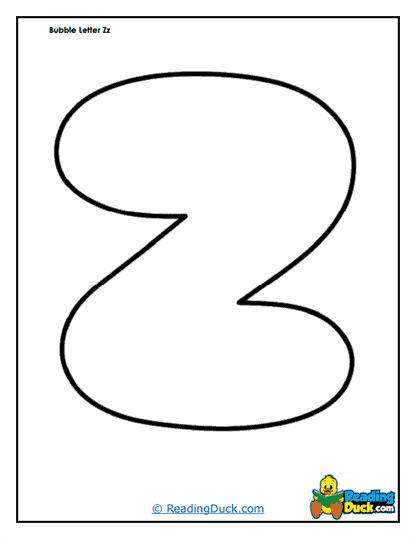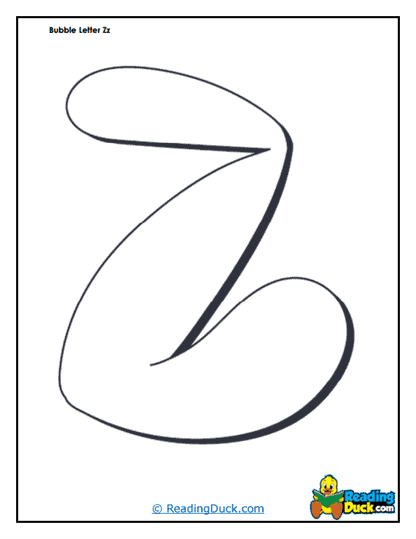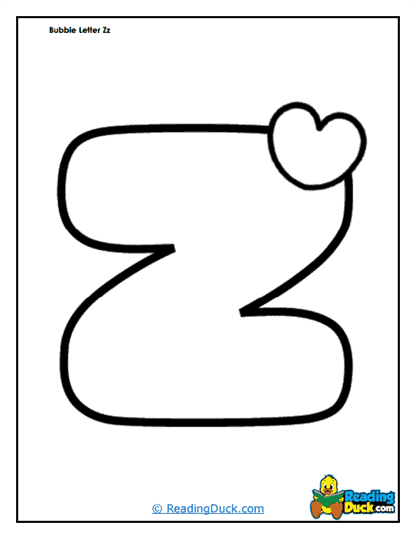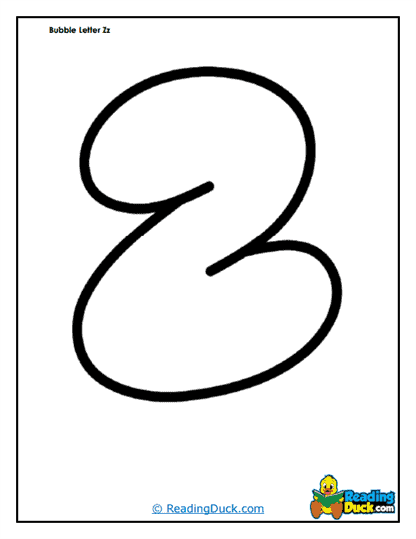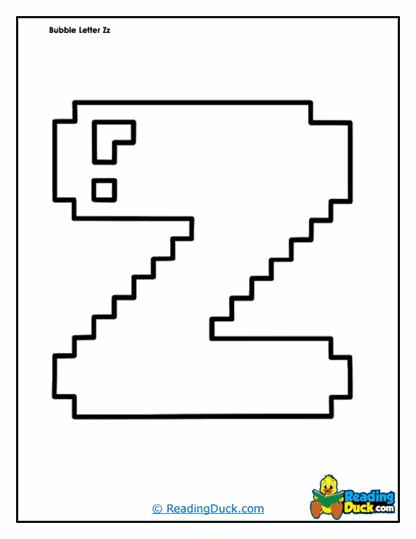Bubble Letter Zz Worksheets
About Our Bubble Letter Zz Worksheets
This worksheet collection, popular for its ease of use and engaging activities is tailored for young learners to develop foundational literacy skills while enjoying a hands-on experience. By incorporating a visually appealing bubble-style font, these worksheets turn learning the letter "Z" into an interactive activity that holds a child’s attention. Children can trace the outlined letter, which helps improve their hand-eye coordination and fine motor skills, essential for writing development. Beyond tracing, the bubble letters provide opportunities for coloring or decorating, allowing children to personalize their learning process and express creativity. These activities not only solidify letter recognition but also build a positive association with learning through fun and artistic expression.
The versatility of these worksheets makes them an invaluable resource in early childhood education, particularly in preschool and kindergarten classrooms. Educators often use these worksheets as part of a structured literacy program to introduce the alphabet in a systematic yet playful manner. For instance, worksheets may include tracing exercises that progress from dashed lines to freehand writing, gradually building the child’s confidence in forming the letter "Z." Accompanying activities, such as identifying objects that start with the letter "Z" or coloring pictures of zebras, zigzags, or zoo scenes, further enhance letter-sound association. Parents can also use these worksheets at home to reinforce classroom learning, making them a versatile tool for blended learning environments.
Beyond their educational benefits, the worksheets foster a holistic learning experience by blending cognitive and artistic development. When children decorate or color the bubble letters, they exercise decision-making and problem-solving skills, such as choosing colors or patterns, which stimulates their imagination. Group activities using these worksheets can also encourage social interaction, as children share ideas or work collaboratively on creative projects. The worksheets can be tailored to various themes, such as holidays or seasons, to keep the content fresh and relevant. This adaptability ensures that learning remains dynamic and enjoyable, helping young learners build a strong literacy foundation while fostering a lifelong love for creativity and exploration.
How Do They Help Young Learners?
Letter Recognition - By focusing on the letter "Z," children develop an awareness of its unique shape and sound, both of which are crucial for foundational literacy. Recognizing the letter "Z" helps children distinguish it from other letters, which is a key step in learning to read. Repeated exposure to "Z" in various contexts reinforces its identity, allowing young learners to identify it more easily in words, sentences, and books. This familiarity extends beyond visual recognition to auditory cues, as children practice associating the sound of "Z" with its written form. Mastering letter recognition at this early stage is essential for progressing to more complex literacy skills, such as decoding and spelling.
Hand-Eye Coordination - Tracing bubble letters on worksheets provides an engaging way for children to improve their hand-eye coordination, an important developmental milestone. As they follow the lines of the letter "Z," they learn to control their pencil or crayon, which requires focus and precision. This activity also helps them connect visual input with physical action, laying the groundwork for smooth and accurate writing. Practicing these movements repeatedly enhances their ability to draw shapes and patterns, which are precursors to writing other letters and numbers. Over time, the discipline required to stay within the lines fosters attention to detail and improves overall motor planning skills.
Fine Motor Skills - Activities like tracing and coloring bubble letters help strengthen the small muscles in the hands and fingers, which are critical for tasks requiring dexterity. These muscles play a significant role not only in writing but also in other everyday tasks, such as buttoning clothes or using utensils. Tracing lines and filling in letters with color demands controlled, deliberate movements that enhance these muscles. Over time, children become more adept at gripping and maneuvering writing tools, making the transition to freehand writing smoother. These skills form a foundation for lifelong abilities, enabling children to write clearly and efficiently as they progress academically.
Creativity - This series worksheets encourage children to unleash their imagination by allowing them to decorate the letters with colors, patterns, or stickers. This freedom to personalize their learning environment makes the experience more engaging and enjoyable, fostering a positive attitude toward education. By experimenting with different designs, children develop problem-solving skills and the confidence to express themselves artistically. Creativity also boosts cognitive development, as children learn to plan and execute their ideas within the framework of the activity. Incorporating personal touches into learning not only reinforces the lesson but also helps children develop a sense of ownership and pride in their work.
Phonics - Including words that start with the letter "Z" (like zebra, zip, and zoo) in these worksheets introduces children to the connection between letters and their corresponding sounds. This letter-sound association, known as phonics, is a cornerstone of early reading instruction. Through matching games, coloring activities, or storytelling, children learn to identify the "Z" sound in different contexts, strengthening their ability to decode words. Repetition of these sounds in fun, interactive ways helps reinforce the learning, making it easier for children to recall and apply this knowledge in reading and writing. Mastering phonics with the letter "Z" builds confidence and prepares children for exploring more complex letter-sound relationships.
Unique Facts About the Letter Z
Origin in Phoenician Alphabet - The letter "Z" traces its origins to the Phoenician letter "zayin," a symbol believed to represent a weapon like a sword or axe. This connection to ancient tools highlights how early alphabets often drew inspiration from everyday objects. Over time, "zayin" evolved into the Greek letter "zeta," marking its inclusion in one of the world's most influential writing systems. The Romans later adopted "Z" into their alphabet, giving it the form we recognize today. This historical journey of the letter "Z" reflects the interconnected evolution of languages and the enduring legacy of ancient civilizations.
Sound Variation - One of the most fascinating aspects of "Z" is its differing pronunciations in American and British English. While Americans pronounce it as "zee," the British call it "zed," a term rooted in the Greek "zeta." This linguistic divergence illustrates how cultural and historical factors influence language development. Beyond English, the sound of "Z" can vary across other languages, showcasing its versatility and adaptability. The differences in pronunciation are not just academic curiosities but reflect broader patterns of regional identity and linguistic tradition.
Rarity - The letter "Z" is one of the least commonly used letters in the English language, appearing less frequently than most others. Despite its rarity, its unique shape and sound make it stand out in both written and spoken contexts. This scarcity also makes "Z" a powerful tool for creating distinctive names, words, or branding elements. In Scrabble and other word games, its infrequent use often adds a level of challenge and strategy. The letter’s rarity underscores its special status as a linguistic and cultural symbol.
Historical Evolution - In ancient Greek, "Z" was the seventh letter of the alphabet and carried the name "zeta." Its transition to the last letter of the Latin alphabet symbolizes the adaptability of written language over centuries. This shift reflects the practical needs and stylistic preferences of different societies as they modified alphabets to suit their linguistic structures. The evolution of "Z" highlights the dynamic nature of language, where even static symbols undergo transformation to meet changing cultural and communication demands. Today, its position as the final letter in the modern English alphabet cements its role as a symbolic "end" or completion.

